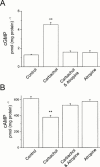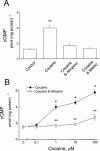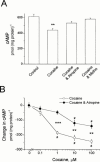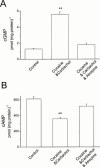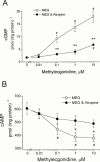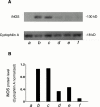Evidence for cocaine and methylecgonidine stimulation of M(2) muscarinic receptors in cultured human embryonic lung cells - PubMed (original) (raw)
Evidence for cocaine and methylecgonidine stimulation of M(2) muscarinic receptors in cultured human embryonic lung cells
Y Yang et al. Br J Pharmacol. 2001 Jan.
Abstract
1. Muscarinic cholinoceptor stimulation leads to an increase in guanylyl cyclase activity and to a decrease in adenylyl cyclase activity. This study examined the effects of cocaine and methylecgonidine (MEG) on muscarinic receptors by measurement of cyclic GMP and cyclic AMP content in cultured human embryonic lung (HEL299) cells which specifically express M(2) muscarinic receptors. 2. A concentration-dependent increase in cyclic GMP production was observed in HEL299 cells incubated with carbachol, cocaine, or MEG for 24 h. The increase in cyclic GMP content was 3.6 fold for 1 microM carbachol (P < 0.01), 3.1 fold for 1 microM cocaine (P < 0.01), and 7.8 fold for 1 microM MEG (P < 0.001), respectively. This increase in cyclic GMP content was significantly attenuated or abolished by the muscarinic receptor antagonist atropine or the M(2) blocker methoctramine. 3. In contrast, cocaine, MEG, and carbachol produced a significant inhibition of cyclic AMP production in HEL299 cells. Compared to the control, HEL299 cells treated with 1 microM cocaine decreased cyclic AMP production by 30%. MEG and carbachol at 1 microM decreased cyclic AMP production by 37 and 38%, respectively. Atropine or methoctramine at 1 or 10 microM significantly attenuated or abolished the cocaine-induced decrease in cyclic AMP production. However, the antagonists alone had neither an effect on cyclic GMP nor cyclic AMP production. Pretreatment of HEL299 cells with pertussis toxin prevented the cocaine-induced reduction of cyclic AMP production. 4. Western blot analysis showed that HEL299 cells specifically express M(2) muscarinic receptors without detectable M(1) and M(3). Incubation of HEL299 cells with cocaine, carbachol, and atropine did not alter the expression of M(2) protein levels. However, the inducible isoform of nitric oxide synthase (iNOS) was induced in the presence of cocaine or carbachol and this induction was significantly attenuated after addition of atropine or methoctramine. 5. The present data show that cocaine and MEG significantly affect cyclic GMP and cyclic AMP production in cultured HEL299 cells. Our results also show that these effects result from the drug-induced stimulation of M(2) muscarinic receptors accompanied with no alterations of receptor expression. However, the induction of iNOS by cocaine may result in the increase in cyclic GMP production.
Figures
Figure 1
Effects of carbachol on cyclic GMP and cyclic AMP production in cultured HEL299 cells. (A) Content of cyclic GMP was measured in the absence (Control, _n_=4) and presence of 1 μ
M
carbachol (Carbachol, _n_=4; P<0.01 vs control), 1 μ
M
carbachol plus 10 μ
M
atropine (Carbachol and Atropine, _n_=4; _P_>0.05 vs control), 10 μ
M
atropine alone (Atropine, _n_=4; _P_>0.05 vs control). (B) Content of cyclic AMP was detected in the absence (Control, _n_=4) and presence of 1 μ
M
carbachol (Carbachol, _n_=4; P<0.01 vs control), 1 μ
M
carbachol plus 10 μ
M
atropine (Carbachol and Atropine, _n_=4; _P_>0.05 vs control), 10 μ
M
atropine alone (Atropine, _n_=4; _P_>0.05 vs control). Statistical significance was tested with unpaired Student's _t_-test. **P<0.01 vs control.
Figure 2
Enhancement of cyclic GMP production in HEL299 cells incubated with cocaine. (A) Compared to the control, content of cyclic GMP was significantly increased in the presence of 1 μ
M
cocaine (Cocaine, _n_=4; P<0.01 vs control). Addition of 10 μ
M
atropine (Cocaine and Atropine, _n_=4, _P_>0.05 vs control) or 1 μ
M
methoctramine (Cocaine and Metho, _n_=5, _P_>0.05 vs control)) abolished the cocaine-induced increase in cyclic GMP production. (B) Concentration-dependent increases in cyclic GMP levels were observed in HEL299 cells incubated with various concentrations of cocaine. Addition of 10 μ
M
atropine significantly attenuated the cocaine-induced enhancement of cyclic GMP production. Each point represents the mean±s.e.mean of at least four measurements. **P<0.01 (tested by unpaired Student's _t_-test between cocaine and cocaine plus atropine). #P<0.01 (tested by ANOVA among control and treated groups with various concentrations of cocaine alone or plus atropine).
Figure 3
Inhibition of cyclic AMP production in HEL299 cells incubated with cocaine. (A) Incubation of HEL299 cells with 1 μ
M
cocaine (Cocaine) significantly reduced cyclic AMP content (_n_=4; P<0.01 vs control). Addition of 10 μ
M
atropine (Cocaine and Atropine, _n_=8, _P_>0.05) or 1 μ
M
methoctramine (Cocaine and Metho, _n_=4, _P_>0.05) abolished the cocaine-induced decrease in cyclic AMP production. (B) Concentration-dependent changes in cyclic AMP content were observed in HEL299 cells incubated with various concentrations of cocaine. The differences of cyclic AMP levels between control and cocaine alone, and between control and cocaine plus atropine are shown. Addition of 10 μ
M
atropine significantly attenuated the cocaine-induced decrease in cyclic AMP production. Each point represents the mean±s.e.mean of at least four measurements. **P<0.01 and ***P<0.001 (tested by unpaired Student's _t_-test between cocaine and cocaine plus atropine). #P<0.01 (tested by ANOVA among control and treated groups with various concentrations of cocaine alone or plus atropine).
Figure 4
Synergic effects of cocaine and carbachol on cyclic GMP and cyclic AMP production in cultured HEL299 cells. (A) Content of cyclic GMP was measured in HEK299 cells for control (Control, _n_=4), 1 μ
M
cocaine plus 1 μ
M
carbachol (Cocaine and Carbachol, _n_=4; P<0.01 vs control), and 1 μ
M
cocaine plus 1 μ
M
carbachol plus 10 μ
M
atropine (Cocaine and Carbachol and Atropine, _n_=4; _P_>0.05 vs control). (B) Compared to control (Control, _n_=4), cyclic AMP production was significantly decreased in HEK299 cells treated with 1 μ
M
cocaine plus 1 μ
M
carbachol (Cocaine and Carbachol, _n_=4; P<0.01 vs control). This reduction was abolished by addition of 10 μ
M
atropine (Cocaine and Carbachol and Atropine, _n_=4; _P_>0.05 vs control). Statistical significance was tested with unpaired Student's _t_-test. **P<0.01 vs control.
Figure 5
Effects of methylecgonidine on cyclic GMP and cyclic AMP production in cultured HEL299 cells. (A) Concentration-dependent increases in cyclic GMP production were observed in HEL299 cells incubated with various concentrations of MEG. Addition of 10 μ
M
atropine significantly attenuated the MEG-induced increase in cyclic GMP production. (B) Concentration-dependent decreases in cyclic AMP were detected in HEL299 cells incubated with various concentrations of MEG. Addition of 10 μ
M
atropine significantly attenuated the MEG-induced inhibition of cyclic AMP production. Each point represents the mean±s.e.mean of 4 – 8 measurements. **P<0.01 (tested by unpaired Student's _t_-test between MEG and MEG plus atropine). #P<0.01 (tested by ANOVA among control and treated groups with various concentrations of MEG alone or plus atropine).
Figure 6
Abolition of the effects of cocaine and carbachol on cyclic AMP production by pertussis toxin. Content of cyclic AMP was measured in cultured HEK299 cells for control (Control), 1 μ
M
cocaine (Cocaine), 1 μ
M
carbachol (Carbachol), 10 ng ml−1 pertussis toxin (PTX), and 1 μ
M
cocaine plus 10 ng ml−1 pertussis toxin (Cocaine and PTX), and 1 μ
M
carbachol plus 10 ng ml−1 pertussis toxin (Carbachol and PTX). Compared to control (Control), cyclic AMP production was significantly decreased in HEK299 cells incubated with 1 μ
M
cocaine (Cocaine) or 1 μ
M
carbachol (Carbachol). This reduction was abolished by addition of 10 ng ml−1 pertussis toxin (Cocaine and PTX, and Carbachol and PTX). Each bar represents the mean±s.e.mean of six measurements. *P<0.05; **P<0.01; ***P<0.001; vs control.
Figure 7
Effects of carbachol and cocaine on the expression of M2 muscarinic receptors in HEL299 cells. Western blot analysis was carried out in cultured HEL299 cells incubated with different compounds for 24 h. The experimental groups were divided as control (a), 1 μ
M
cocaine (b), 1 μ
M
carbachol (c), 10 μ
M
atropine (d), 1 μ
M
cocaine plus 1 μ
M
carbachol (e), 1 μ
M
cocaine plus 10 μ
M
atropine (f), 1 μ
M
cocaine plus 1 μ
M
carbachol plus 10 μ
M
atropine (g), 1 μ
M
carbachol plus 10 μ
M
atropine (h).
Figure 8
Induction of iNOS by cocaine in HEL299 cells. Western blot analysis was carried out in cultured HEL299 cells incubated with different compounds for 24 h. The experimental groups were divided as control (a), 10 μ
M
cocaine (b), 1 μ
M
carbachol (c), 10 μ
M
cocaine plus 10 μ
M
atropine (d), 1 μ
M
carbachol plus 10 μ
M
atropine (e), 10 μ
M
cocaine plus 1 μ
M
methoctramine (f). Note the induction of iNOS by cocaine and carbachol and the abolishment by addition of atropine or methoctramine.
Similar articles
- Enhancement of nitric oxide production by methylecgonidine in cultured neonatal rat cardiomyocytes.
Yang Y, Liao H, Ke Q, Cai J, Xiao YF, Morgan JP. Yang Y, et al. Br J Pharmacol. 2002 Jan;135(1):188-96. doi: 10.1038/sj.bjp.0704414. Br J Pharmacol. 2002. PMID: 11786494 Free PMC article. - Dual effects of muscarinic M(2) acetylcholine receptors on the synthesis of cyclic AMP in CHO cells: dependence on time, receptor density and receptor agonists.
Michal P, Lysíková M, Tucek S. Michal P, et al. Br J Pharmacol. 2001 Mar;132(6):1217-28. doi: 10.1038/sj.bjp.0703931. Br J Pharmacol. 2001. PMID: 11250872 Free PMC article. - Muscarinic cholinergic stimulation of the nitric oxide-cyclic GMP signaling system in cultured rat sensory neurons.
Bauer MB, Murphy S, Gebhart GF. Bauer MB, et al. Neuroscience. 1994 Sep;62(2):351-9. doi: 10.1016/0306-4522(94)90370-0. Neuroscience. 1994. PMID: 7530344 - Muscarinic regulation of the L-type calcium current in isolated cardiac myocytes.
Méry PF, Abi-Gerges N, Vandecasteele G, Jurevicius J, Eschenhagen T, Fischmeister R. Méry PF, et al. Life Sci. 1997;60(13-14):1113-20. doi: 10.1016/s0024-3205(97)00055-6. Life Sci. 1997. PMID: 9121355 Review. - Biochemical characterization of the muscarinic receptors.
Sokolovsky M, Gurwitz D, Kloog J. Sokolovsky M, et al. Adv Enzymol Relat Areas Mol Biol. 1983;55:137-96. doi: 10.1002/9780470123010.ch2. Adv Enzymol Relat Areas Mol Biol. 1983. PMID: 6312781 Review. No abstract available.
Cited by
- The muscarinic effect of anhydroecgonine methyl ester, a crack cocaine pyrolysis product, impairs melatonin synthesis in the rat pineal gland.
Medeiros de Mesquita LS, Garcia RCT, Amaral FG, Peres R, Wood SM, Lucena RL, Frare EO, Abrahão MV, Marcourakis T, Cipolla-Neto J, Afeche SC. Medeiros de Mesquita LS, et al. Toxicol Res (Camb). 2017 Mar 29;6(4):420-431. doi: 10.1039/c7tx00009j. eCollection 2017 Jul 1. Toxicol Res (Camb). 2017. PMID: 30090510 Free PMC article. - Anhydroecgonine Methyl Ester (AEME), a Product of Cocaine Pyrolysis, Impairs Spatial Working Memory and Induces Striatal Oxidative Stress in Rats.
Gomes EF, Lipaus IFS, Martins CW, Araújo AM, Mendonça JB, Pelição FS, Lebarch EC, de Melo Rodrigues LC, Nakamura-Palacios EM. Gomes EF, et al. Neurotox Res. 2018 Nov;34(4):834-847. doi: 10.1007/s12640-017-9813-y. Epub 2017 Sep 15. Neurotox Res. 2018. PMID: 28914428 - Enhancement of nitric oxide production by methylecgonidine in cultured neonatal rat cardiomyocytes.
Yang Y, Liao H, Ke Q, Cai J, Xiao YF, Morgan JP. Yang Y, et al. Br J Pharmacol. 2002 Jan;135(1):188-96. doi: 10.1038/sj.bjp.0704414. Br J Pharmacol. 2002. PMID: 11786494 Free PMC article.
References
- BENCHIMOL A., BARTALL H., DESSER K.B. Accelerated ventricular rhythm and cocaine abuse. Ann. Intern. Med. 1978;88:519–520. - PubMed
- BILLMAN G.E., LOPPI M.D. Effects of cocaine on cardiac vagal tone before and during coronary artery occlusion: cocaine exacerbate the autonomic response to myocardial ischemia. J. Cardiovasc. Pharmacol. 1993;22:869–876. - PubMed
- CHAMBERS H.F., MORRIS D.L., TAUBER M.G., MODIN G. Cocaine use and the risk for endocarditis in intravenous drug users. Ann. Intern. Med. 1987;106:833–836. - PubMed
Publication types
MeSH terms
Substances
LinkOut - more resources
Full Text Sources
